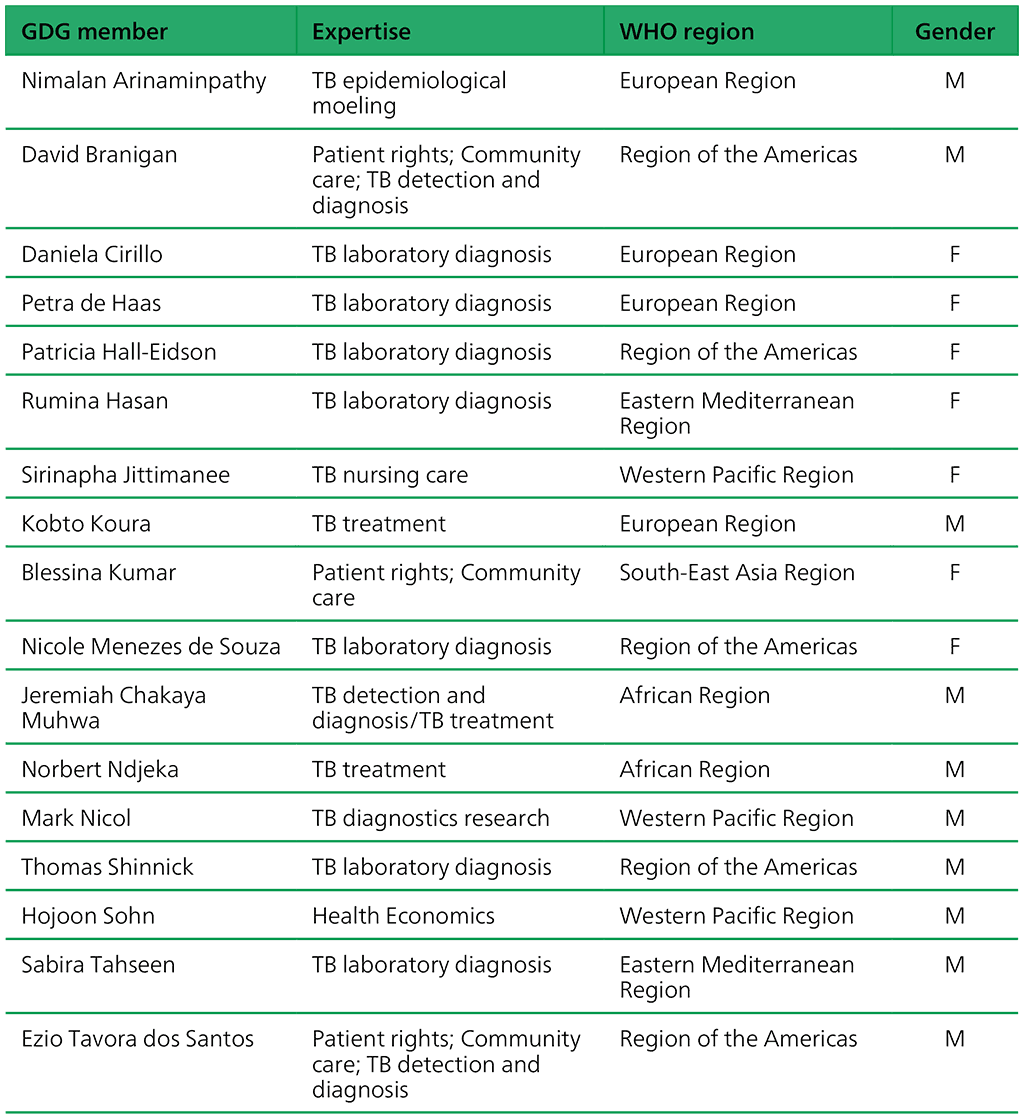Consolidated Guidelines
Annex 3: Guideline development group members
Table A.3.1. Guideline development group members: “Targeted next-generation sequencing” 2–5 May 2023


9. References
- Global tuberculosis report 2021. Geneva: World Health Organization; 2021 (https://apps.who.int/iris/handle/10665/346387, accessed 1 December 2021).
- Marais B. The natural history of childhood intra-thoracic tuberculosis: a critical review of literature from the pre-chemotherapy era. Int J Tuberc Lung Dis. 2004;8(4):392-402.
- Martinez L, Cords O, Horsburgh CR, Andrews JR, Pediatric TB Contact Studies Consortium.
Annex 1. WHO recommendations incorporated in the guidelines on the management of TB in children and adolescents
In order of presentation:
WHO consolidated guidelines on tuberculosis. Module 2: screening - systematic screening for tuberculosis disease. Geneva: World Health Organization; 2021.
Recommendations for investigating contacts of persons with infectious tuberculosis in low- and middle-income countries. Geneva: World Health Organization; 2012.
WHO guidelines on tuberculosis infection prevention and control, 2019 update. Geneva: World Health Organization; 2019.
8. Research priorities
This chapter includes research gaps or priorities that were identified by the GDG members while considering the evidence related to each of the PICO questions. Addressing the identified research gaps has the potential to inform the development of future research questions that can improve TB prevention and care. This list of research priorities is not exhaustive; but it complements the existing research agenda outlined in Research priorities for paediatric tuberculosis (127) and other WHO guidelines.
6.1.4. Monitoring and evaluation
Moving to decentralized, family-centred, integrated services requires careful planning and regular monitoring of implementation against the plan. The capacity needs of NTPs for implementing the proposed interventions need to be identified and addressed.
6.1.3. Implementation considerations
Health system requirements: Training of health care workers at peripheral levels of the health system is a critical requirement to ensure adequate implementation of decentralized approaches. Similarly, resources are needed at the peripheral level, especially initially to establish services. It is expected that as services are established and effectively implemented, the long-term impact will result in a decrease in TB incidence with an associated reduction in resource requirements.
6.1.2. Subgroup considerations
Adolescents have a disease presentation that is similar to adults, and therefore may need different interventions than young children. Additional subgroup considerations for adolescents are included in the operational handbook, taking into account their specific health-seeking behaviour and the need for adolescent-friendly services.
6.1.1. Justification and evidence
PICO questions:
a. In children and adolescents with signs and symptoms of TB, should decentralization of child and adolescent TB services versus centralized child and adolescent TB services (at referral or tertiary hospital level) be used?
b. In children and adolescents exposed to TB, should decentralization of child and adolescent TB prevention and care services versus centralized prevention and care services (at referral or tertiary hospital level) be used to increase coverage of TPT in eligible children and adolescents?
6.1. Decentralized and family-centred, integrated models of care to deliver child and adolescent TB services
Recommendations:
In TB high burden settings, decentralized models of care may be used to deliver TB services to children and adolescents with signs and symptoms of TB and/or those exposed to TB (conditional recommendation, very low certainty evidence).
Family-centred, integrated models of care to deliver TB services may be used in children and adolescents with signs and symptoms of TB and/or those exposed to TB, in addition to standard models of care (conditional recommendation, very low certainty evidence).
Pagination
- Previous page
- Page 11
- Next page

 Feedback
Feedback